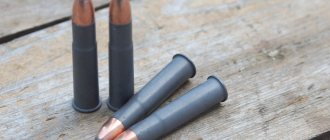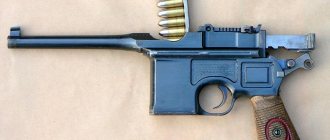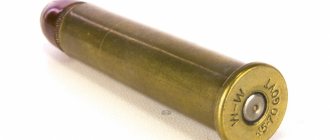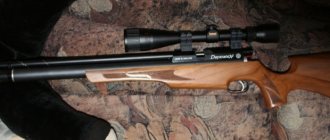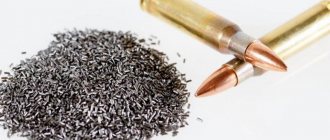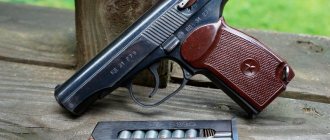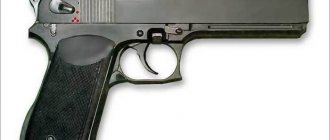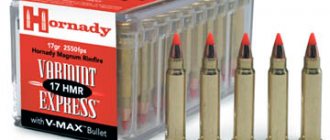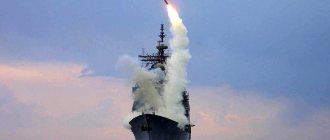Preface
1 PREPARED by the Autonomous non-profit organization “Research Center for Control and Diagnostics of Technical Systems” (ANO “SRC KD”) based on its own translation into Russian of the English version of the standard specified in paragraph 4
2 INTRODUCED by the Technical Committee for Standardization TC 358 “Acoustics”
3 APPROVED AND ENTERED INTO EFFECT by Order of the Federal Agency for Technical Regulation and Metrology dated December 15, 2009 N 865-st
4 This standard is modified from the international standard ISO 17201-4:2006* “Acoustics. Noise produced at shooting ranges. Part 4. Prediction of projectile sound" (ISO 17201-4:2006 "Acoustics - Noise from shooting ranges - Part 4: Prediction projectile sound", MOD) by introducing technical deviations, the explanation of which is given in the additional appendix YES. By introducing additional provisions, phrases, links, as well as changing individual structural elements highlighted in italics in the text**.
________________
* Access to international and foreign documents mentioned in the text can be obtained by contacting the User Support Service.
** In the original, the designations and numbers of standards and normative documents in sections “Preface”, 2 “Normative references”, appendices DA and DB are given in regular font, marked in these sections with the sign “**” in italics; the rest of the document text is given in bold italics. — Notes from the database manufacturer.
When applying this standard, it is recommended to use, instead of reference international standards, the corresponding national and interstate standards, information about which is given in the additional appendix DB
5 INTRODUCED FOR THE FIRST TIME
6 REPUBLICATION. November 2022
The rules for the application of this standard are established in
Article 26 of the Federal Law of June 29, 2015 N 162-FZ “On Standardization in the Russian Federation”**.
Information about changes to this standard is published in the annual (as of January 1 of the current year) information index “National Standards”, and the official text of changes and amendments is published in the monthly information index “National Standards”. In case of revision (replacement) or cancellation of this standard, the corresponding notice will be published in the next issue of the monthly information index “National Standards”. Relevant information, notices and texts are also posted in the public information system - on the official website of the Federal Agency for Technical Regulation and Metrology on the Internet (www.gost.ru)
Introduction
The sound of a shot generally consists of three components: the muzzle wave, the shock wave and the sound of the bullet. This standard deals with the sound of a bullet generated when flying at supersonic speeds.
This standard specifies a method for calculating the sound impact level of a bullet. The method for calculating the parameters of bullet sound propagation differs from similar parameters of sound propagation from other sources.
The sound of a bullet is considered to originate from a point in its trajectory, called the source point. The level of sound impact of a bullet is calculated based on geometric parameters and bullet speed. The dependence of the frequency spectrum of the sound impact of a bullet on the distance to the source point due to nonlinear effects is taken into account. Methods are given for calculating the level of sound exposure based on the level of sound exposure at the observation point, taking into account geometric attenuation, attenuation due to nonlinear effects and sound absorption by the atmosphere. Additionally, the effect of reducing bullet speed and atmospheric turbulence was taken into account.
In a limited area of space (region II - see section 4), the sound impact levels of a bullet are comparable to the sound impact level of a muzzle wave. Outside this area, only the diffracted or scattered sound of a bullet at significantly lower levels propagates. The sound of a bullet behind area II (area I) is significantly weaker than the sound of a muzzle wave. This standard provides the procedure for calculating levels in areas I and II. In [1] the results of measurements and calculations are presented for several calibers and distances, i.e. depending on the source point and observation point. The calculation results overestimate the sound of a bullet by an average of 1.8 dB A.
Why do we hear the sound of a gunshot?
Shot sound
audible, because the bullet (if its speed exceeds the speed of sound) generates a head shock (ballistic) wave, and powder gases create a muzzle wave. ... Gases flying out of the barrel following the bullet and overtaking it; sound level - 115-135 dB.
Interesting materials:
How to hide the applications folder on iPhone? How to hide an application on iPhone using commands? How to hide an application on iPhone on the desktop? How to hide the text of a message on Instagram on an iPhone? How to hide a call on iPhone? How to hide notes on iPhone? How to hide dialogues in VK from an iPhone? How to monitor traffic consumption on iPhone? How to fold iPhone headphones? How to listen to music for free on iPhone?
1 area of use
This standard specifies a calculation model for determining the 1/3-octave spectrum of a bullet's sound exposure level for geometric mean frequencies in the range 12.5 Hz to 10 kHz and a method for calculating the sound exposure level at the observation point.
This standard applies to bullets with a caliber of less than 20 mm, but can be applied to larger calibers. The calculation results can be used to compare the sound radiation from the explosion of various types of ammunition used with a certain type of weapon. The standard applies to civilian weapons, but can be applied to military weapons.
The calculation method can be used to estimate environmental noise. The prediction method is applicable in open space conditions, with a straight trajectory and a streamlined bullet shape. Due to the latter circumstance, this method is not applicable to calculating the sound of a shot shell. The parameter values used in this standard as known a priori are given for a temperature of 10°C, relative air humidity of 80% and atmospheric pressure of 1013 hPa. Appendix A can be used for calculations under other atmospheric conditions. To obtain more accurate results on sound absorption in air, calculations are performed in 1/3-octave frequency bands, since sound absorption in air is significant in the specified frequency range.
Problems of supersonic flight
No matter how fast an ordinary plane accelerates, it will not be able to fly at supersonic speed for a long time. Subsonic aircraft have smoother and more rounded shapes. But when flying at supersonic speed, different aerodynamic conditions arise.
Air resistance increases sharply, and the aircraft body heats up due to friction. As a result, an ordinary plane will lose stable control and may begin to collapse right in the air.
Supersonic aviation began to actively develop in the 50-60s. The first supersonic aircraft to be mass produced was the North American F-100 Super Saber fighter. This model first flew in 1953.
Interesting: Why do the plane’s engines stop after takeoff and it seems like it’s falling?
Passenger supersonic aircraft were also created that operated regular flights. But there were only 2 of them: the Soviet Tu-144 and the Anglo-French Concorde.
Supersonic passenger aircraft Tu-144
The advantage of such aircraft is that they cover long distances in a short period of time. Also, a supersonic aircraft travels at a higher altitude compared to conventional ones. Accordingly, the airspace is not congested. But their use was soon abandoned due to several disadvantages:
- shock wave;
- high fuel consumption;
- complexity of operation;
- noise over the airfield.
A loud bang is a sudden surge in pressure in front of the aircraft, which occurs when the aircraft begins to move at supersonic speed (breaks the sound barrier). The shock wave arising in front of the aircraft propagates in a cone shape. A person watching the flight of an airplane hears a pop when this wave reaches him, and only after that can the engine be heard. The shock wave constantly accompanies the aircraft at supersonic speed. However, the pops will only be heard when the plane passes at a certain point - close to the observer.
2 Normative references
This standard uses normative references to the following standards:
GOST 31295.1** (ISO 9613-1:1993) Noise. Attenuation of sound as it propagates over terrain. Part 1. Calculation of sound absorption by the atmosphere
GOST 31295.2 (ISO 9613-2:1996) Noise. Attenuation of sound as it propagates over terrain. Part 2. General method of calculation
GOST R 53570 (ISO 17201-1-2005) Acoustics. Noise produced at shooting ranges. Part 1. Determination of the acoustic characteristics of the muzzle wave by measurements
Note - When using this standard, it is advisable to check the validity of the reference standards in the public information system - on the official website of the Federal Agency for Technical Regulation and Metrology on the Internet or using the annual information index "National Standards", which was published as of January 1 of the current year, and on issues of the monthly information index “National Standards” for the current year. If an undated reference standard is replaced, it is recommended that the current version of that standard be used, taking into account any changes made to that version. If a dated reference standard is replaced, it is recommended to use the version of that standard with the year of approval (adoption) indicated above. If, after the approval of this standard, a change is made to the referenced standard to which a dated reference is made that affects the provision referred to, it is recommended that that provision be applied without regard to that change. If the reference standard is canceled without replacement, then the provision in which a reference to it is given is recommended to be applied in the part that does not affect this reference.
3 Terms and definitions
This standard uses terms and definitions in accordance with GOST R 53570, as well as the following terms with corresponding definitions:
3.1 streamlined bullet
(streamlined projectile): A body of revolution whose first derivative of the cross-sectional area with respect to the coordinate along the axis of the bullet, starting at the nose, is a continuous function of 0.
3.2 effective bullet length
(effective projectile length),
m
: The distance along the axis of the bullet from the nose to the coordinate at which the cross-section of the bullet is maximum (see Figure 1).
- effective bullet length; - maximum bullet diameter
Figure 1 - Effective bullet length
3.3 N-wave
(N-wave): A wave in which the sound pressure increases abruptly to a maximum, decreases linearly to a minimum and then increases abruptly to its original value (see Figure 2).
- time; — sound pressure
Figure 2 - Time dependence of the sound pressure of a supersonic bullet in the N-wave
3.4 N-wave duration
(duration time),
s
: Interval between time points in which the N-wave increases abruptly.
NOTE Due to nonlinear acoustic effects, it varies along the N-wave propagation path.
3.5 characteristic frequency
(characteristic frequency),
Hz
: The reciprocal of the N-wave duration.
3.6 coordinate system
(, ) , m: A flat rectangular coordinate system in which the axis, starting from the muzzle, coincides with the line of fire.
Note - The sound field of a bullet is axisymmetric relative to the line of fire, so the coordinate plane (, ) can be inclined to the horizontal plane at an arbitrary angle.
3.7 coherence distance
(coherence distance),
m
: The distance between the trajectory point and the observation point, above which the sound radiation of adjacent parts of the bullet trajectory becomes incoherent at the observation point due to atmospheric turbulence.
3.8 Mach number
(Mach number): The ratio of the bullet's speed to the speed of sound.
3.9 source point
(source point): The point at which a line drawn from the observation point perpendicular to the wavefront intersects the bullet's trajectory.
NOTE In this standard, the source point is used to represent a path that is a linear sound source [see formula (4)].
3.10 source sound exposure level
(source sound exposure level),
dB
: Sound exposure level at a distance of 1 m from the source point.
Note - A distance of 1 m from the source point in the direction of the observation point is called the reference distance.
3.11 muzzle velocity
(projectile launch speed),
m/s
: The speed of the bullet when leaving the muzzle.
3.12 bullet speed
(projectile speed),
m/s
: The speed of the bullet along the trajectory.
3.13 final speed
(end speed),
m/s
: The speed of the bullet at the moment it hits the target or at the trajectory point where the Mach number decreases to 1.01.
3.14 sound speed reference
(reference sound speed),
m/s
: Adiabatic speed of sound in air, averaged over a time interval of at least 10 minutes.
3.15 fluctuating effective speed of sound
(fluctuating effective sound speed),
m/s
: The sum of the instantaneous adiabatic speed of sound and the instantaneous horizontal component of wind speed in the direction of sound propagation.
3.16 standard deviation of fluctuating acoustic refractive index
(standard deviation of the fluctuating acoustical index of refraction),
m
: Standard deviation of the ratio of the reference sound speed to the fluctuating effective sound speed.
Note - In this standard in accordance with [2] 10 [see. formula (12)].
3.17 change in bullet speed
(projectile speed change),
1/s
: Change in bullet speed per unit trajectory length.
Notes
1 The unit of measurement for the change in bullet speed is the reciprocal second [(m/s·m)=1/s].
2 This value is negative for non-reactive bullets (projectiles).
Sound speed
Against the background of puffs of black smoke, a trickle appears
white steam After some time a whistle is heard. It is the driver who gives the signal that the train is approaching.
A fiery flash pierces the darkness of the night, and after a few seconds the sound of an artillery gun is heard.
Watch a carpenter work from a distance. You will easily notice that when the carpenter raises the ax for the next blow on the wood, the sound is heard only from the first blow.
All this convinces us that light and sound travel at different speeds. Light outpaces sound, which is why we see first and then hear. The speed of light is the fastest speed in nature: it is equal to 300 million meters per second. The speed of sound in air is only about 340 meters per second, i.e. 900 thousand times less.
It is interesting to note that the speed of a bullet when leaving a rifle barrel is almost three times the speed of sound. When a bullet flies in a straight line, that is, along the same path as the sound, it overtakes the sound of the shot. In this case, the sound cannot serve as a warning. It's a different matter when firing from howitzers or mortars. Here the projectile flies along a curve (with a large elevation angle); its path to the target is thereby lengthened, and the sound of the shot can outstrip the projectile.
You can even follow the movement of the sound wave with your eyes! Imagine that there is a long column of people with an orchestra in front. Everyone steps to the beat of the music. But if you look from the outside, it is easy to notice that the last rows do not keep pace with the first.
This happens because the sound of the orchestra reaches the back rows later.
But the speed of sound is not constant. Even in the same substance it is not always the same. So, in the air at twenty degrees below zero, sound travels 318 meters per second, and at 20 degrees Celsius - 342.5 meters. Sound also travels at different speeds in different solids and liquids.
Rice. 10. Measuring the speed of sound in water. The man sitting in this boat transmits the sound
The speed of sound in water was first measured in 1827. A bell was lowered into the water from the side of one boat on a rope (Fig. 10). The second boat was at a distance of 13,847 meters from the first (Fig. 11). At the moment when the hammer hit the bell on the first boat, a flash of gunpowder was simultaneously produced on it. On the second boat, a man observed the moment of the flash and noted the moment of arrival of the sound from the bell. In this way, the time it took a sound wave to travel the distance between the boats through the water was calculated. It turned out that the speed of sound in water is four times greater than in air. In one second, sound travels 1435 meters in water.
In most solids the speed of sound is even greater. For example, in wood it reaches 4800 meters, in steel - 5000 meters, in glass - 5600 meters per second.
Rice. 11. Measuring the speed of sound in water. Here a person perceives sound
Sounds of different heights travel in the same substance at the same speed. If this were not so, then it would be impossible to listen to music from afar. Some sounds would overtake others, and instead of a harmonious melody, far from the orchestra, just noise would be heard.
Some tribes, for example, the tribes of equatorial Africa, still directly use sound as a means of communication. For this purpose, special drums are most often used. Heard in one place, conditioned sound signals are immediately transmitted
further. In this way, very soon the entire tribe is notified of some event.
This method, however, requires a lot of time. Let's calculate, for example, how quickly a sound signal can be transmitted from Moscow to Leningrad. The distance between these cities is 640 kilometers. Let us assume that sound in the air travels 340 meters in one second.
If we could shout so loudly that the sound from Moscow could reach Leningrad, we would be heard in 31 minutes. But the sound quickly weakens with distance and soon becomes inaudible. To transmit sound over such a long distance, it must be reproduced along the way with renewed vigor as it fades. To do this, people would have to be placed at a certain distance from each other. Each of them, having heard the signal from a neighbor located closer to Moscow, must immediately transmit it to his neighbor in the direction of Leningrad. It is clear that such a transfer will take much more than half an hour.
After the invention of the telephone, telegraph and radio, this method of transmitting sound over long distances lost its meaning.
Modern methods of communication are based on the fact that sound is transmitted over long distances using electric current through wires (telephone), or using electromagnetic waves propagating in space almost instantly (radio).
When a person speaks into a microphone connected to an electrical circuit, sound waves cause electrical vibrations. These vibrations travel at the speed of light through wires or air. The receiving station converts the received signals into sounds again. In this case, sound waves travel a very short path: from the person speaking to the microphone and from the telephone handset or loudspeaker to the ear of the listener. The rest of the distance, the sound is, as it were, “transported” by electromagnetic vibrations. Thanks to this method of transmission, sounds are instantly transferred over thousands of kilometers.
Imagine two people, one of whom is listening to a concert in the hall of the Moscow Conservatory, and the other at home, on the radio, somewhere in the Far East. Which of them will hear music first?
If the first one is 15-20 meters from the orchestra, then the sounds will reach it through the air in approximately 0.05 seconds.
These same sounds, transmitted through a microphone to a radio station and then into space using radio waves, will rush at a speed of 300 thousand kilometers per second and in 0.05 fractions of a second they will end up somewhere in the Pacific Ocean or America. They will reach our listener in about half the specified time. And it turns out that someone listening on the radio at a distance of 7-8 thousand kilometers hears the sounds of music 0.02-0.03 fractions of a second earlier than a person in a concert hall!
4 Characteristic areas of sound propagation
The wave front originating in the nose of the bullet has the shape of a cone (see Figure 3). The speed of the bullet decreases along the trajectory. As a consequence, the wave front is bent. There are three regions (I, II and III) of sound propagation (see Figure 3). The level of sound exposure in areas I and III is significantly lower compared to area II. This standard proposes a calculation model for sound exposure levels in areas II and III. Sound exposure levels in region I are negligible compared to the muzzle wave. Bullet speed is calculated according to the formula
, (1)
where is the coordinate of the bullet, m.
The boundaries of area II are determined by the angles and (see Figure 3). These angles are calculated using the formulas:
, (2)
where is the final velocity of the bullet, m/s;
— speed of sound, m/s.
1
- weapon;
2
- source point;
3
- bullet trajectory;
4
- wave front;
5
- target;
6
- bullet;
7
- observation point
Figure 3 - Three areas of bullet sound propagation
The speed of sound is a function of the absolute air temperature in degrees Kelvin and is determined by the formula
, (3)
where 283.15 K (10°C);
337.6 m/s (speed of sound at ).
At subsonic bullet speed, the angle is 0, i.e. Region III does not exist. The target in this case is considered to be the point of the trajectory where the Mach number decreases to 1.01.
What is the sound barrier?
The sound barrier in the field of aerodynamics is a technical difficulty that arises as a result of phenomena associated with the movement of an aircraft at a speed equal to or exceeding the speed of sound.
You need to understand that this is not a real obstacle that the plane must overcome, like some kind of invisible wall, but more of an abstract concept. It arose at a time when aviation was just thinking about aircraft that could move at high speed - supersonic. Many even insisted that such results were unattainable.
5 Description of the source
5.1 Source point
The coordinates of the source point (,0) can be determined by iteration. For straight trajectories they should be determined by the formula
, (4)
where (, ) are the coordinates of the observation point.
If the coordinates of the source point are further from the target or observation point in area III, then the target is taken as the source point.
5.2 Sound exposure level
Wideband sound impact level of a bullet, dB A
calculated by the formula
, (5)
where 169.9 dB A
relative to (20 μPa) (see A.2);
— the Mach number of the bullet at the source point for the bullet speed calculated by formula (1) and the speed of sound calculated by formula (3) at the air temperature for which the level of sound impact of the bullet is predicted;
m.
In principle, the full length of the bullet can be used instead of the effective one to calculate the broadband sound exposure level, but in this case the full length should also be used to calculate the shape factor and its constant (see Appendix A).
If the Mach number approaches unity, then the third term in formula (5) becomes uncertain. Therefore, the lower limit for the Mach number in this formula is taken to be 1.01.
The sound spectrum of a bullet can be calculated using the Fourier transform of the N-wave. It is assumed that the 1/3-octave spectrum of the sound exposure level at the observation point has a roll-off at low and high frequencies and a single characteristic frequency, calculated by the formula
, (6)
where is the distance from the source point to the observation point, m;
- reference frequency equal to 175.2 Hz at 10°C (see A.3).
Note - From formula (6) it follows that the characteristic frequency decreases with increasing distance, which is a consequence of pulse broadening due to nonlinear effects.
In the geometric mean frequency range from 12.5 Hz to 10 kHz for standard 1/3-octave filters, the 1/3-octave sound exposure level is calculated using the formula
, (7)
Where
; (8)
; (9)
; (10)
— geometric mean frequency of the 1/3-octave band (11 corresponds to a frequency of 12.5 Hz, 40 to a frequency of 10 kHz).
6 Calculation of sound exposure levels
6.1 Basic relationships
The values of the 1/3-octave spectrum of the sound exposure level at the observation point are necessary to calculate the attenuation caused by factors that reduce the amplitude of the sound as it propagates, starting from a distance of 1 m to the observation point at a distance of . The 1/3-octave spectrum is calculated using the formula
, (11)
where is the 1/3-octave sound exposure level at the geometric mean frequency at a distance of 1 m from the source point [see. formula (7)], dB A
;
— geometric attenuation of the sound level in a sound field free of obstacles as a result of an increase in the wave front area with increasing distance, starting from a distance of 1 m, dB A
;
— nonlinear attenuation due to nonlinear effects associated with high initial sound pressure near the source point, dB A
;
— attenuation caused by sound absorption in the atmosphere during sound propagation, starting from a distance of 1 m to the observation point, dB A
;
— additional attenuation due to the influence of the ground, atmospheric refraction and shielding by obstacles, dB A
.
Note - As the sound of a bullet travels from a distance of 1 m to the observation point, attenuation includes losses due to: interaction of the sound wave with the ground surface; refraction or curvature of the sound trajectory caused by gradients in the vertical profile of sound speed in air; screening by obstacles. GOST 31295.2 provides methods for calculating additional attenuation factors when predicting sound. See A.4 for guidance on taking into account the influence of obstacles.
6.2 Calculation of attenuation due to the influence of various factors
6.2.1 Geometric attenuation
To calculate the geometric attenuation, it is necessary to distinguish between the positions of the observation point in regions II and III. In region II, the geometric attenuation varies in the range of values from 10 lg to 25 lg dB (is the distance from the source point to the observation point) due to two effects:
a) reducing the speed of the bullet;
b) atmospheric turbulence.
At short distances the first effect predominates. Starting from the coherence distance, the second effect dominates. At distances over 10 km from the source point on the trajectory of a bullet (projectile), the attenuation tends to the limit of 20 log dB as in a spherical sound wave [2].
Coherence distance, m, is calculated by the formula
, (12)
where is the total trajectory length both to the target and to the point where the local Mach number decreases to 1.01 m;
m, (see [2]);
;
— Mach number at the source point;
— speed of sound at a given air temperature [see. formula (3)], m/s.
Geometric attenuation in region II is calculated using the formulas:
; (13)
, (14)
Where ; 1m.
In region III, geometric attenuation is calculated using the formula
, (15)
where the distances and are shown in Figure 4.
The first term in formula (15) is the geometric attenuation, calculated using formula (13) or (14) for - the distance from the target to the projection of the observation point onto the boundary of regions II and III closest to it. The second term depends on the distance of the observation point to the boundary of regions II and III (see Figure 4).
6.2.2 Nonlinear attenuation
If the observation point is in region II, then the attenuation due to nonlinear wave propagation is calculated using the formula
. (16)
1
- weapon;
2
- bullet trajectory;
3
- target;
4
— observation point;
5
- wave front
Figure 4 - Distances at the observation point in area III
If the observation point is in region III, then the nonlinear attenuation is calculated using formula (16), but should be replaced by .
A typical dependence of nonlinear attenuation on is shown in Figure 5.
; m; m; — nonlinear attenuation, dB A
; — distance from the source point to the observation point, m
Figure 5 - Nonlinear attenuation as a function of distance
6.2.3 Sound absorption in the atmosphere, additional attenuation and the influence of obstacles
The attenuation in 1/3-octave frequency bands caused by absorption in the atmosphere as sound propagates from the source point, starting at a distance of 1 m, is calculated by the formula
, (17)
where is the absorption coefficient in the atmosphere of a pure tone at the geometric mean frequency at given atmospheric pressure, temperature and relative air humidity (see), dB A
/m.
Note - The calculation method according to formula (17) and GOST 31295.1 does not take into account the broadening of the sound pulse due to nonlinear effects, due to which the spectral components of sound energy shift to low frequencies. According to formula (6), the characteristic frequency decreases with increasing distance from the source to the observation point in inverse proportion to the distance. As a result, the spectrum of the source will shift to the low frequency region as the distance from the source to the observation point increases. Since high-frequency spectral components exist near the sound source, absorption will be higher near it. However, the method provides a good approximation to reality, since the frequency shift is only significant near the source.
The ground attenuation, which is part of , can be calculated by a suitable method for predicting sound propagation in open space (for example, according to GOST 31295.2). For different characteristics of the earth's surface and meteorological conditions, the parabolic equation method can be applied [3].
An approximate calculation of the influence of obstacles is given in A.4.
Sound or light - which is faster?
At zero air temperature, the speed of sound is 331 m/s. At 20°C - 344 m/s. A sound wave travels not only in air, but also in liquids and solids. It is known that the more a substance resists compression, the better it conducts sound. So, the speed of sound in water is 1484 m/s. Metals, for example, aluminum, steel, iron, conduct sound at a speed of 5000-6000 m/s, and sapphire - at a speed of 11400 m/s.
The value of the speed of light obtained by Roemer was slightly adjusted, and more than once, because the methods of measurements and calculations changed over time. Light travels a distance of 150 million km in 8 minutes. Its speed is slightly less than 300 thousand km/s, but for the convenience of calculations it is customary to round the value.
Today science knows for certain: light is what is fastest in the world. In other words, these particles move the fastest.
7 Uncertainty of calculation results
It is recommended to estimate the uncertainty of the results of calculating the 1/3-octave spectrum of the sound impact level of the source according to [4].
The uncertainty arises both from the uncertainty in the calculation of the 1/3-octave sound exposure level of the source and from the influence of the uncertainty of various attenuation factors.
The expanded uncertainty of measurement should be calculated with a confidence level of 95% according to [4].
Recommendations for assessing uncertainty are given in Appendix B.
Appendix B (for reference)
Recommendations for assessing uncertainty
B.1 General provisions
A method for determining measurement uncertainty is established [4]. It is based on budgeting components determined by various sources of uncertainty. With their estimates, the overall measurement uncertainty can be determined. The following are recommendations based on the known sources of uncertainty in the quantities presented in the calculation models of this standard.
B.2 Uncertainty of the 1/3-octave spectrum of the sound exposure level
B.2.1 Calculation formula
The 1/3-octave sound exposure level at the observation point is calculated using the formula
, (IN 1)
where is the 1/3-octave sound exposure level at the geometric mean frequency at a distance of 1 m from the source point [see. formula (7)], dB A
;
— correction for divergence of the spherical wave front, dB A
;
— correction for the influence of nonlinear effects associated with high sound pressure near the source point, dB A
;
— correction for sound absorption in air, dB A
;
— correction taking into account the interaction of sound with the earth’s surface, atmospheric refraction and shielding by obstacles, dB A
.
Each value is assigned a probability distribution [normal, rectangular, -distribution (Student distribution), etc.]. The expected value (mean) is the best estimate of a quantity, and its standard deviation characterizes its spread (called standard uncertainty). The measurement uncertainty of each of the quantities in formula (B.1) contributes to the overall uncertainty.
B.2.2 Components of forecast uncertainty
Contributions to the overall measurement uncertainty depend on the particular uncertainties and the corresponding sensitivity factors. Sensitivity coefficients are a measure of the influence of changes in the corresponding quantities on the values of the 1/3-octave spectrum of the sound exposure level. Mathematically, they are equal to the partial derivative of a function that expresses the dependence of the determined quantity on the quantity influencing it. The contribution of the influencing quantity is determined by the product of the standard uncertainty and the sensitivity coefficient of the determined quantity to changes in the influencing quantity. The information required to determine the overall measurement uncertainty is given in Table B.1.
Table B.1 — Uncertainty budget for 1/3-octave sound exposure level spectrum
| Magnitude | Rating, dB A | Standard uncertainty, dB A | Probability distribution | Sensitivity factor | Contribution to uncertainty, dB A |
| 1 | |||||
| 1 | |||||
| 1 | |||||
| 1 | |||||
| 1 | |||||
| The estimate, probability distribution and corresponding standard deviation shall be determined for each quantity on the basis of available information or by appropriate agreement. Standard uncertainty is less than 1 dB A. Compared to the standard uncertainty, the uncertainties of other corrections are negligible. The standard uncertainty can be found using GOST 31295.2. | |||||
B.2.3 Total and expanded forecast uncertainty
The overall uncertainty of the 1/3-octave spectrum of the sound exposure level is calculated using the formula
. (AT 2)
In accordance with [4], the expanded uncertainty is determined from the condition that the actual value is covered by an interval with a confidence probability of 95%. The expanded measurement uncertainty is calculated using the formula , where is the coverage coefficient corresponding to the required confidence level.
Table B.2 — Coverage coefficients for different coverage probability values
| Probability of coverage under normal distribution, % | Coverage ratio |
| 67 | 1,0 |
| 80 | 1,3 |
| 90 | 1,6 |
| 95 | 2,0 |
| 99,9 | 2,6 |
LiveInternetLiveInternet
In the first part of the article “Alien Technogen,” it was concluded that man-made signs in the events at the Dyatlov Pass point to the killing of nine tourists with an “unidentified type of weapon,” the striking element of which was a high-velocity, small-diameter arrow-shaped bullet. Based on the sum of the facts, it turned out that the speed of that bullet was no less than 3000 m/sec. Such a speed is inaccessible to modern technologies of mankind, so it was concluded that an Alien man-made agent was used at the Dyatlov Pass. The first person to come to a similar conclusion was investigator Ivanov, who was investigating this case in 1959. Who else can be trusted if not him, who knew much more than is reflected in the official materials of the investigation. He publicly outlined his version in the article “The Mystery of Fireballs” after he became the prosecutor of the Kustanai region back in the days of the USSR. In this article, he directly stated that the cause of death of the tourists was the use of an unknown weapon. People who have reached such positions are very stingy with sensational statements, so let's treat his words with respect.
What happened at the Dyatlov Pass is not an isolated incident; at least one more similar incident in the mountains of Buryatia is reliably known.
You can read it here: https://taina.li/forum/index.php?topic=1127.0 Everything was exactly the same there, tourists (7 people) first jumped out of the tent in a half-naked state, ran in panic down the slope, and when they tried returning back to the tent they died, it is officially believed that they died from hypothermia (let’s translate from forensic to normal, Russian, without discernible external and internal damage). Only one participant in the events survived, who did not return back to the tent, but hid in the taiga, but he didn’t really say anything afterwards, and now it’s unlikely that he will be found and questioned with passion…. So events with signs of the presence of Alien technogen occur from time to time, not en masse, of course, but they do occur, and this article is not an excursion into history, but an attempt to look into the future. But closer to the topic, even though it is man-made, most likely Alien, this does not mean that it is fantastic. Any man-made product must be based on the laws of physics, and we can fully understand how it was implemented and what effects accompanied its use. The physical effects of high-velocity bullets flying close to a person (warning shots) and the traumatic impact of such a bullet hitting the body are very unusual and have no direct analogues in our everyday world. Even experts in the field of small arms do not imagine these effects; they have never encountered such weapons in practice, so they will have to describe them purely theoretically, calculating what is called “at the tip of the pen.” This is the subject of the second part of the article. Hypothetical bullet - speed clarification First, about the fundamental point in the hypothesis of killing tourists with an “unidentified type of small arms,” namely the speed of the bullet. In the first part of the article it was said that to inflict the injuries that were found on the bodies of tourists (for example, 10 broken ribs), a miniature bullet weighing about a gram requires a speed of at least 3000 m/sec. But the facts point to an even higher speed of bullets, here is the most paradoxical of them. The leader of the group, Igor Dyatlov, died just 400 meters from the location of the rest of the tourists, in the line of sight, but the remaining tourists did not notice this, and waited for at least another two hours for the return of their leader. They approached him only when it was a little dawn and his body became visually visible in the snow. For ordinary supersonic bullets this is simply unrealistic, they are very “noisy”, the sound of their flight can be heard a kilometer or two away, it cannot be confused with anything. Tourists would immediately recognize this sound, especially since the group included a front-line soldier who went through the entire war. It seems like an end to the hypothesis of death from the use of small arms, but don’t rush to conclusions. The intensity of the sound of a bullet passing, of course, only increases with increasing speed, but for the human ear there is one fundamental limitation. If the duration of the sound is less than 1/20 of a second, then the human ear cannot distinguish such a short sound, no matter how strong and frequency it is. The same applies to visual perception; this is the psychophysics of our nervous system; it cannot respond to short impulses. It is because of this psychophysical feature that we have the opportunity to watch movies and television, where frames (static pictures) change 24 times per second but appear to us as a continuous image, and not a “slide show”. Accordingly, if we assume that they shot from the top of height 1079, where the tourists were heading up the slope, then this is a distance of about two kilometers. During the flight of a two-kilometer distance, the sound of a bullet will not be recognized by the human ear only if its speed is at least 30-40 km/sec. This is a lot, nothing is known about such weapons yet, but this does not mean that they do not exist. It is this gigantic speed of bullets that explains all the oddities discovered by search engines at the scene of events. Necessary condition And so, suppose that we have a certain “device” that can accelerate objects weighing about a gram to speeds of about 30 km/sec. We won’t discuss how it works here, but this is a realistically achievable speed even for modern technologies, although not small arms, but space ones. What is more important for us is the bullet itself that he accelerates, because it was the bullet that left marks on the terrain and killed people. The first question that arises is whether such a high-speed bullet can fly in the atmosphere a distance sufficient for practical use in weapons, which is at least a kilometer. At this speed, due to friction with the air, an ordinary bullet will heat up and burn out without flying even hundreds of meters. Aerodynamically, you can reduce the coefficient of friction by giving a high-speed object a needle shape, similar to the shape of arrow-shaped bullets of small diameter, in this case the friction with the air will drop sharply, since the friction force is proportional to the square of the bullet diameter. For example, when the diameter of a bullet is halved, the friction force will decrease by four times. For a needle weighing one gram of depleted uranium (four times heavier than steel) and a diameter of one millimeter, the length would be about 50 millimeters, an elongation of 1:50, this is similar to the arrows of armor-piercing sabot projectiles. Only without feathering, it is not effective at such speeds; such a bullet needs to be stabilized by rotation, as in a rifled weapon. The aerodynamic method can significantly reduce friction, but in general this is not enough; a more effective method is needed. Shiryaev used a revolutionary method of reducing the friction of a bullet on the air in his arrow-shaped large-caliber bullet; the Askoria rifle is currently equipped with cartridges with these bullets. He used a pyrophoric substance to generate a plasma cloud around the moving arrow. In fact, the plasma cloud served as the cavitation cavity of the Shkval rocket-torpedo cavitator. In both cases, the principle and physical effects of the movement are completely similar. The effectiveness of the method has been confirmed in practice, at least by the very fact of the existence of the Shkval missile-torpedo and Shiryaev’s arrow-shaped bullets. Let me explain what plasma is, this is a region of space where molecules are divided into ions and electrons, torn from the outer orbits of an atom. Low-temperature and highly ionized plasma is practically a vacuum cavity where charged particles move chaotically at speeds of hundreds of kilometers per second. For example, the speed of molecules in air under normal conditions is only about 300-400 meters per second. An example of such a plasma is ball lightning, here it is in the video:
The phenomenon is rare; in fact, this is the only reliable public video where ball lightning is filmed up close. So the plasma cavity in the atmosphere is a complete physical analogue of the cavitation cavity in water; it remains to understand how to place a pyrophoric substance in such a small object as a needle of millimeter diameter. But here everything is simple, it is enough to use depleted uranium as the needle material, as in armor-piercing shells. The fact is that uranium is very pyrophoric, and it begins to burn in an oxygen environment already at 150 degrees. The combustion energy of uranium is tens of times greater than the energy of combustion of gunpowder and detonation of TNT. The effect of uranium burning in oxygen is already being used in armor-piercing shells, but not yet to increase the firing range, but to increase the destructive effect. Due to the low speed of the projectile, when moving in the atmosphere, it cannot warm up to the combustion temperature; this temperature occurs only at the moment of penetration of the armor, and then, having pierced the armor and heated up, it completely burns out the entire armored space. You can see how this happens in the video:
Now let’s take a closer look at what was captured on the video, it’s very unusual... The tank was pierced by a uranium shell at the moment of the first “flash” on the turret armor; it was the “ablative” fragments of the uranium core outside the tank that caught fire. The hole from the breakdown of the armor by the uranium core is very small, and has characteristic features; it looks like this in a cut:
The hole is more reminiscent of a “burn through” of a cumulative jet, the only difference is the profile of the input channel on the left, there is a clear “puncture” characteristic of armor-piercing cores, behind which the combustion zone begins, more reminiscent of a channel pierced by a cumulative jet. A shot from an LNG (mounted anti-tank grenade launcher) captured in the video accelerates an armor-piercing core weighing about a kilogram to a speed of no more than 900 m/sec. Cores made of steel or tungsten are driven into the armor like “nails” by LNG; in order to cause serious damage to the tank, it must hit the vital components of the tank. In our case, the shell hit the top of the turret, the tank can receive dozens of such “punctures” and remain in combat condition. Uranium cores “work” in a completely different way. Through a hole in the tank’s armor, about a kilogram of uranium that crumbles into dust and ignites is “injected”; combustion occurs at a temperature of 2500 degrees. The first torch in the video is the burning of fragments of the uranium core inside the tank, the second torch is from the ignition (without detonation) of shots from the standard ammunition stowage. So compare the power of the torches from the combustion of just a kilogram of uranium and at least 100 kilograms of gunpowder... In the case of a uranium needle moving in the atmosphere at a speed of about 30 km/sec, the needle will heat up to the combustion temperature of uranium after flying no more than ten meters and will begin to burn to create a plasma shelter that will sharply reduce resistance to the movement of such a bullet. Uranium has another useful property, a high degree of ablation; in other words, it is a self-sharpening effect associated with low thermal conductivity. Because of this effect, the tip of the needle will not be what is called “blunt” when moving, and the combustion itself will occur only at the very tip of the needle. Let's summarize: Firstly, for uranium needles of small diameter, flight speeds in the atmosphere of the order of 30 km/sec are not fantastic, and since they are physically quite real, let's call them for brevity in the future “Hypersonic Bullets”. Secondly, if we turn to the topic of the Dyatlov Pass, then the radioactive stains found on the clothes of tourists could well have remained from being damaged by such uranium needles. Sufficient condition Radioactive stains are an indirect and very unreliable sign of a technogen in the events at the Dyatlov Pass; rely on it and do not respect yourself. Hypersonic bullets have what is called “dropping like a stone” on the spot. This effect is due to the fact that at high speeds and small diameters of the bullet, a very small part of its kinetic energy (no more than 1/10) is transferred to the victim’s body; this energy is simply not enough to throw the body away. However, the effect of a body falling towards a hypersonic bullet is pure physics, there is no mysticism here. Look at the picture of a ball flying at a speed of 3 km/sec; its diameter is 5 millimeters.
We are interested in the zones of rarefaction and vacuum cavities remaining in the air after the ball has passed. The maximum width of this zone will be approximately equal to the diameter of the flying object multiplied by the ratio of the object's speed to the speed of sound. For the case of a needle with a diameter of 1 mm flying at a speed of 30 km/sec (we will also round the speed of sound to 300 m/sec for an even count), the diameter of such a vacuum zone will be at least 10 cm, there will be a practical vacuum. The length of such a vacuum channel will be equal to half the diameter of the vacuum zone multiplied by the ratio of the speed of the object to the speed of sound and will be at least 5 meters. When hit by a hypersonic bullet, in addition to the direct traumatic effect, a vacuum channel with a diameter of at least 10 cm and a length of at least 5 meters will rest against the body. In fact, this is equivalent to a push (force impulse) with a force of about 50-70 kg towards the movement of the bullet with a duration of 5/300 = 1/60 sec. In terms of force impulse, this is approximately equivalent to hitting the body with a sledgehammer, only not directly, but through a board... In such conditions, the body falling towards the direction of movement of the hypersonic bullet is inevitable. This is an exclusively theoretical conclusion based on the elementary laws of physics; in practice, everything is much more complicated, but the effect of falling towards the shot and its approximate force of at least 50 kg for the specified parameters of a hypersonic bullet is a fact. I hope after this “hands-on” explanation, the physics of the process becomes clear; there is nothing mystical in this seemingly paradoxical effect. If we return to the topic of the pass, the three bodies found in the bed of the stream have clear signs of collapsing to meet the traumatic effects. Three more bodies that died in the movement to the top of height 1079 were also found maximally extended towards the top, from where they were fired upon. But there are no obvious injuries on the bodies. Apparently the bullets did not touch the bones; all the damage was described in their abdomen and lower back. Shock wave of hypersonic bullets It is known from physics that any object moving in the atmosphere at a speed greater than the speed of sound always creates a shock wave, so a hypersonic bullet should create such a shock wave. There were no obvious evidence of the presence of a shock wave on the ground, otherwise it would have been known. There are only indirect facts, one of them is clearly stated in the materials of the UD during the interrogation of expert Vozrozhdeniy, here is his testimony:
In addition, the shock wave is indicated by the fact that three mechanical watches of tourists stopped in an interval of less than half an hour (according to the indications on the dial); this is a clear sign of shock impact. Shock wave, shock wave, discord, they are different. We simply associate their presence on an everyday, everyday level with an explosion, but this is not the only source of shock waves. The shock wave from supersonic motion is known as "supersonic aircraft transition". For the average person, this specific cotton does not carry with it any “catastrophic” associations due to ignorance, however, it is a powerful and destructive physical effect. The military seriously tried to use such shock waves to destroy large concentrations of enemy manpower. The United States carried out work on the creation of such weapons at the end of the 50s of the last century, and in the USSR the same principles of a shock wave to destroy enemy personnel were put into practice at the end of the 60s of the last century. Here is a real prototype of such a weapon, a kind of “supersonic iron”:
This is an experimental Myasishchev M-25 attack aircraft, which was supposed to be armed with a supersonic shock wave. Based on the decision of the Presidium of the NTS MAP dated July 17, 1969, work began on creating an aircraft capable of supersonic flight at low altitudes (up to 30–50 m). The energy of the shock wave reaching the ground, according to calculations by specialists from the Institute of Theoretical and Applied Mechanics (ITPM) of the Siberian Branch of the USSR Academy of Sciences, was more than enough to guarantee injury (concussion) to the personnel of the enemy troops. So the air shock wave from the passage of a hypersonic bullet is not science fiction, and traces of it are in photographs from the criminal case materials, here is one of them again:
The front-line artilleryman who participated in the investigation of this incident (Prosecutor Tempalov) identified them as craters from small-caliber shells. In addition to the shells (they were never discovered, so the version was dropped), a series of such breaches could well have been left by the shock wave of hypersonic bullets. In the picture, the gaps are visually estimated to be 20-30 centimeters wide; it must be taken into account that they were made not in loose snow, but in firn, in compacted snow, on which searchers walked without falling through. So, judging by the photographs, the energy of the shock wave was very high; if such a hypersonic bullet flew close to a person at a distance of a meter and a half, then he would be guaranteed a severe concussion, which would mean loss of consciousness and death. At long distances there would be the effect of dizziness, loss of coordination and orientation, deafness, in short, the usual set of injuries with mild contusions. At the same time, a person would not even understand what happened - he would not hear a sound due to the short duration of the shock wave. The effect of the shock wave from the “warning shots” while the tourists were in the tent could well have been the reason for their hasty escape from the tent, half naked. Yes, in fact, only the impact of the shock wave from warning shots with hypersonic bullets can explain this, at first glance, causeless “run” of half-naked tourists for one and a half kilometers into a shelter (ravine). Well, the last thing that remains not understood is that strange external injuries were found on the bodies of tourists; they are certainly not fatal, but nevertheless it is impossible to explain their appearance by “natural” causes (even “beatings”). They can only be explained by one thing: it was snowing during the events at the pass... Snowflakes that fell into the area of the shock wave accelerated to speeds of about 1-2 km/sec and left characteristic streaks and “bruises” on the skin. And finally, I will say... The version of the death of the Dyatlov group from the use of hypersonic bullets, for all its apparent “insanity,” of course has a right to exist. There are no facts yet to definitively confirm or refute it. The truth is, as always, somewhere nearby. But this doesn’t matter, the main question is completely different. A chain of reasoning led to the justification of the possibility of hypersonic flight in the atmosphere. And this is more important than searching for the truth in those distant and for the most part no longer interesting events on the snowy slope of height 1079. It remains to understand how you can accelerate a bullet to speeds of at least 10-15 km/sec. There is reason to believe that this is possible without the use of any fantastic technologies. Modern technology may well make it possible to create such weapons based on already known physical principles. And the question now is: how to do this?
Author R_T_T
topwar.ru/56657-chuzhoy-tehnogen-nikakoy-mistiki-tolko-fizika.html
Series of messages “SPACE, UFOs”:
Part 1 — Inside the shuttle Part 2 — UFOs: from observations from satellites in 2011 ... Part 10 — “Angara” did not fly: the launch was postponed indefinitely Part 11 — “Liquidator” of Roscosmos will engage in orbital cleaning Part 12 - Alien man-made. No mysticism - only physics Part 13 - "TITANIC" DID NOT DIED FROM A COLLISION WITH AN ICEBERG Part 14 - Interesting figures and facts about our planet... Part 39 - Earth from space. Amazing photos Part 40 - 11 magnificent images from the “Astronomical Photographer of the Year” Part 41 - Alien tricks
Appendix YES (reference)
Technical deviations of this standard from the international standard ISO 17201-4:2006 applied in it
This standard has the following technical deviations from the international standard ISO 17201-4 applied in it:
DA.1 Section 2 in accordance with the requirements of GOST R 1.5-2004 is supplemented by the standards GOST R 53570-2009, GOST 31295.1-2005**, GOST 31295.2-2005 instead of the corresponding international standards, which are referenced in the text of the applied international standard.
YES.2 In the “Bibliography” structural element, ISO/IEC Guide 98-3:2008 has been added, which is referenced in the text of the standard, other sources are given in the order of mention in the text.
YES.3 In terminological articles, notes containing explanations regarding the units of measurement of the quantities being determined and their designations are excluded. In accordance with GOST R 1.5-2004, designations of units of measurement of quantities are given after the term.
YES.4 The terminology clause has been renumbered from 3.10 to 3.9 in order to define the term “source point” before its first use.
YES.5 The note to the term “bullet speed” has been excluded as it is not related to this term. The note is worded as follows:
“Note—Published data regarding bullet speed versus distance are related to air density above sea level. When changing altitude above sea level, the change in air density must be taken into account.”
YES.6 Bibliographic sources are given in the order of their mention in the text of the standard.
Appendix DB (reference)
Information on the compliance of reference interstate and national standards with international standards used as reference in the applied international standard
Table DB.1
| Designation of the reference national, interstate standard | Degree of compliance | Designation and name of the reference international standard |
| GOST 31295.2-2005 (ISO 9613-2:1996) | MOD | ISO 9613-2:1996 “Acoustics. Attenuation of sound as it propagates over terrain. Part 2. General method of calculation" |
| GOST R 53570-2009 (ISO 17201-1:2005) | MOD | ISO 17201-1:2005 “Acoustics. Noise produced at shooting ranges. Part 1. Determination of the muzzle wave by measurements" |
| Note - This table uses the following conventions for the degree of compliance with standards: — MOD — modified standards. | ||


